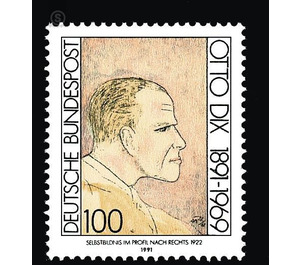100th birthday of Otto Dix - Germany / Federal Republic of Germany 1991 - 100 Pfennig
Theme: Calender
| Country | Germany / Federal Republic of Germany |
| Issue Date | 1991 |
| Face Value | 100.00 |
| Color | yellow |
| Perforation | K 13 3/4: 14 |
| Printing Type | Five-color gravure printing squeegee |
| Stamp Type | Postage stamp |
| Item Type | Stamp |
| Chronological Issue Number | 1446 |
| Chronological Chapter | GER-BRD |
| SID | 522427 |
| In 35 Wishlists | |
"Either I become notorious or famous" - this saying of Otto Dix has come true. The artist, born in Gera on 2 December 1891, became both, albeit at different times. Dix came from a humble background, his father was a cast iron molder. During his schooldays he has a talent for drawing and painting, and in 1905 he begins a decorative painting apprenticeship. It was not until 1909 that he was able to go to the School of Applied Arts in Dresden, equipped with a scholarship. There he mainly pursues landscape painting, first self-portraits emerge. In his early work, the influence of van Gogh and the Brücke painter is palpable. Only the experience of the First World War, in which Dix, like many of his contemporaries participate as a volunteer at the front, changes his understanding of art and style of painting sustainable. New themes are now defining his work, Dix is working on the war experiences over the next 15 years again and again. In 1919 he began to study at the Academy of Arts in Dresden in order, as he later put it, to become "a real painter". Dix joins the »New Dresden Secession Group 1919« and becomes a member of the »November Group«. He paints and colors Dadaist portraits with a new theme. Eros, death and the war as fascination and perversion at the same time are now the subject of his painting. At the beginning of the 20's he developed a new style. Otto Dix becomes the exact critical observer of his time. The portrayal of social marginal groups and the consequences of the war, as well as a subtle rendition of his contemporaries make him the outstanding portraitist and one of the most important representatives of the Verismus, the social-critical direction of the New Objectivity. In 1922 he goes to Düsseldorf, where he finishes his studies in academia and joins the artist group »Young Rhineland«. He stands trial for "painted pornography" and advances to "civil terror". In the fall of 1925 he leaves Dusseldorf and moves to the metropolis of Berlin. Dix becomes a sought-after portraitist, he paints intellectuals, friends, patrons, entrepreneurs, marginalized people of society and dazzling figures of the cityscape. In 1927 Dix became a professor at the Dresden Academy of Arts and in 1931 the Prussian Academy of Arts appointed him a member. In 1933, he was one of the first to be relieved of his post by the National Socialists and was banned from exhibiting because of the "defamation-inducing" and "immoral" statement and effect of his pictures. He is one of the main victims of the exhibition "Degenerate Art" in Munich, where eight of his paintings, many of his watercolors, drawings and graphics are shown. Almost all public works are confiscated in 1937/38. Nevertheless, Dix does not leave Germany, but "emigrates" to his exile in Hammenhofen on Lake Constance, devotes himself to landscape painting and paints some coded political allegories. In February 1945 he was drafted into the Volkssturm and for the second time experienced the horrors of the war. After the Second World War, he is often honored, but his representational painting does not correspond to the new art flow, the international abstraction. Dix creates an extensive late work until his death in 1969, in which not only landscape and portrait but also Christian themes play a role. The motif shows the painting "Selbstbildnis", 1922, watercolor and pencil on cardboard, 43.8 x 28.9 cm, Von der Heydt-Museum, Wuppertal. On the self-portrait of 1922, he is 31 years old. His contemporaries described him: "His sharply cut Germanic face is devastated, gray. He has the mouth of the ruthless instinctual man with the brutally outstretched lower lip and deep lines around the corners, the gray eyes of the sober analyst, the finely cut nose of the clear emotional man, the eyebrow of the desperate thinker, the brushed hair of the American ... His Muscular work hands are neglected, because he is a proletarian by birth, by instinct, by rebellion. The feelings of belonging to the working class are counteracted by his refined demands for life and his tremendous sensitivity. He does not tolerate the plumpness of proletarian behavior, the narrow horizon, the dependent mass instinct. So he moves uprooted between classes. "(Text: Dr. Sabine Fehlemann, Wuppertal) (Text: Andrea Hollmann, Stuttgart)


